I'm planning a pair with about $300 per driver. In terms of SPL I mean more dynamic headroom is better, right?
The Peerless XLS drivers used to be popular some years ago. Not sure they make them any more or are they just out-dated performance wise?
The Peerless XLS drivers used to be popular some years ago. Not sure they make them any more or are they just out-dated performance wise?
Just no longer available for retail customers.
Excellent performance even by 2022 standards.
Here was one of the last variants; the Tymphany Peerless XXLS 12” aluminium cone model 835017 ;
4 ohm nominal impedance; designed for sealed boxes.
Here it is my measurement in a 1 cu ft sealed.
Distortion in absolute SPL-

Distortion in relative terms (dB)

Free air impedance testing
Green- cone in free air ( neutral position)
Pink - cone pushed (and held in)
Blue- cone pulled out (and held out)

Other 12” drivers which may* have similarly low distortion (at similar price point) are:
Dayton RSS-315HF-4
Eminence Lab 12
Similar distortion albeit higher price point:
SEAS L26ROY
Lowest distortion at higher price point
Purifi PTT10.0X (a 10” that can beat a 12”)
More output below 80Hz:
CSS SDX-12
More output and lower distortion below 80Hz:
Bigger drivers with equal Vd, or more Vd. 😜
* based on publicly available data; I have not done head to head comparisons myself.
Excellent performance even by 2022 standards.
Here was one of the last variants; the Tymphany Peerless XXLS 12” aluminium cone model 835017 ;
4 ohm nominal impedance; designed for sealed boxes.
Here it is my measurement in a 1 cu ft sealed.
Distortion in absolute SPL-
Distortion in relative terms (dB)
Free air impedance testing
Green- cone in free air ( neutral position)
Pink - cone pushed (and held in)
Blue- cone pulled out (and held out)
Other 12” drivers which may* have similarly low distortion (at similar price point) are:
Dayton RSS-315HF-4
Eminence Lab 12
Similar distortion albeit higher price point:
SEAS L26ROY
Lowest distortion at higher price point
Purifi PTT10.0X (a 10” that can beat a 12”)
More output below 80Hz:
CSS SDX-12
More output and lower distortion below 80Hz:
Bigger drivers with equal Vd, or more Vd. 😜
* based on publicly available data; I have not done head to head comparisons myself.
Last edited:
From long stroke woofers I used the SS 26W/4558T00 (same as the alu diaphragm Peerless XXLS), it looked very good on paper but the sound was a big disappointment with it's "lifeless", laid back character. I really wanted this woofer to sound good but no matter what I tried, the base character remained.
Reading the comments in this thread, this driver is an opposite of a short stroke, low Mms, highly efficient, thin surround woofer. But I don't know if that's the reason for it's soundcharacter.
Reading the comments in this thread, this driver is an opposite of a short stroke, low Mms, highly efficient, thin surround woofer. But I don't know if that's the reason for it's soundcharacter.
How did you use it?
I’m using the 835017 in a 28L sealed cabinet well stuffed with glass wool; with 100W (4 ohm) amp. In half space (2 pi) it looks something like this- which gives it a bit of boost around 100Hz:

But it’s used in my son’s cabinet for his e-drum kit; with the 100W amp only able to push it to a maximum excursion of ~6mm (out of its Klippel rated 14mm x-max) at 10Hz. This gives a dry but punchy sound. He’s only been drumming for less than a year; and I’m no drummer; so I can’t really comment on how good everything is.
BUT, A higher sensitivity 12” designed for a vented box, with ~7mm x-max, in a PA style cabinet, even if it had a little more harmonic distortion (overtones)… well it would give more dynamic range, and perhaps a bit more character. Remember that H2 is precisely one octave higher that the fundamental- so it’s related musically. HD3 is a perfect 5th and HD4 is 2 octaves higher, so they are also related musically. (That’s why THD is poorly correlated with perceptual problems; as it’s 2 largest components are the musically related H2 and H3)
It’s really the H5, H6, H7 and H9 that are not musically related, and all the extraneous noises, like farting/chuffing port noises, whistling under the cone because of lack of pole vent etc that would be apparent.
It’s a shame www.data-bass.com went down. That was a treasure trove of test data for sub-bass drivers starting at around 15” or more… the odd 10 or 12 was considered “small”
I’m using the 835017 in a 28L sealed cabinet well stuffed with glass wool; with 100W (4 ohm) amp. In half space (2 pi) it looks something like this- which gives it a bit of boost around 100Hz:
But it’s used in my son’s cabinet for his e-drum kit; with the 100W amp only able to push it to a maximum excursion of ~6mm (out of its Klippel rated 14mm x-max) at 10Hz. This gives a dry but punchy sound. He’s only been drumming for less than a year; and I’m no drummer; so I can’t really comment on how good everything is.
BUT, A higher sensitivity 12” designed for a vented box, with ~7mm x-max, in a PA style cabinet, even if it had a little more harmonic distortion (overtones)… well it would give more dynamic range, and perhaps a bit more character. Remember that H2 is precisely one octave higher that the fundamental- so it’s related musically. HD3 is a perfect 5th and HD4 is 2 octaves higher, so they are also related musically. (That’s why THD is poorly correlated with perceptual problems; as it’s 2 largest components are the musically related H2 and H3)
It’s really the H5, H6, H7 and H9 that are not musically related, and all the extraneous noises, like farting/chuffing port noises, whistling under the cone because of lack of pole vent etc that would be apparent.
It’s a shame www.data-bass.com went down. That was a treasure trove of test data for sub-bass drivers starting at around 15” or more… the odd 10 or 12 was considered “small”
Last edited:
I used in a 50 L vented and in a 20 L sealed. The punch is exactly what I missed. Then this woofer replaced by a 12" pro sound woofer (lower Mms, shorter stroke, thinner verge) and everything fell in place, of course with a different crossover because of the different sensitivity.
My personal view is that original Peerless XLS 830452 (marketed as 10” but outer diameter 11”, and the 12” 830500 made it easy for DIYers; just drop it in tiny (1/2 to 1 cu ft) with matching passive radiators and BOOM; fantastic little subwoofers!
Then they released all these other variants with different numbers and it became confusing. What to choose?
Dayton did better by giving clear recommendations and after sales support about how to use their RSS series.
I was tempted to use the 26/4558T as a woofer in 3 way- but in the end; I could not see how to do so. The sensitivity is rather low. So let’s use them in pairs, if the price is right. It then Impedance drop to below 2 ohm. And if put them in series the impedance is 8 ohms. but then you’re back at square one- you now have low sensitivity again.
The 12” 8 ohm paper cone XXLS 830845, on the other hand, Well that was a subwoofer suitable for use a woofer. Nothing funky going on up to around 550Hz; so you could use it up to 250-300Hz. after baffle step losses, In pairs the sensitivity is a healthy 92dB/2.83V, and the impedance is 4 ohms. This is what a use in my 3 way, with F3 ~40Hz and F10 ~30Hz. This doesn’t sound very low, but is similar to pro audio “subwoofers” - lots of output in the chest thump/rumble region of music; whilst ignoring most of the 16 to 31Hz for dinosaur stomps; tanks explosions needed for home theatre.
It is a shame now that’s it gone. But there are available substitutes:
https://www.diyaudio.com/community/...stions-for-end-game-3-way.402411/post-7430675
Then they released all these other variants with different numbers and it became confusing. What to choose?
Dayton did better by giving clear recommendations and after sales support about how to use their RSS series.
I was tempted to use the 26/4558T as a woofer in 3 way- but in the end; I could not see how to do so. The sensitivity is rather low. So let’s use them in pairs, if the price is right. It then Impedance drop to below 2 ohm. And if put them in series the impedance is 8 ohms. but then you’re back at square one- you now have low sensitivity again.
The 12” 8 ohm paper cone XXLS 830845, on the other hand, Well that was a subwoofer suitable for use a woofer. Nothing funky going on up to around 550Hz; so you could use it up to 250-300Hz. after baffle step losses, In pairs the sensitivity is a healthy 92dB/2.83V, and the impedance is 4 ohms. This is what a use in my 3 way, with F3 ~40Hz and F10 ~30Hz. This doesn’t sound very low, but is similar to pro audio “subwoofers” - lots of output in the chest thump/rumble region of music; whilst ignoring most of the 16 to 31Hz for dinosaur stomps; tanks explosions needed for home theatre.
It is a shame now that’s it gone. But there are available substitutes:
https://www.diyaudio.com/community/...stions-for-end-game-3-way.402411/post-7430675
Last edited:
Thanks for the data! Do you know where I can see distortion for the Dayton RSS series? TBH I'm a bit confused by the many variants, not to mention the Ultimax and Mx series.Just no longer available for retail customers.
Excellent performance even by 2022 standards.
Here was one of the last variants; the Tymphany Peerless XXLS 12” aluminium cone model 835017 ;
4 ohm nominal impedance; designed for sealed boxes.
Here it is my measurement in a 1 cu ft sealed.
Distortion in absolute SPL-
View attachment 1204482
Distortion in relative terms (dB)
View attachment 1204483
Free air impedance testing
Green- cone in free air ( neutral position)
Pink - cone pushed (and held in)
Blue- cone pulled out (and held out)
View attachment 1204484
Other 12” drivers which may* have similarly low distortion (at similar price point) are:
Dayton RSS-315HF-4
Eminence Lab 12
Similar distortion albeit higher price point:
SEAS L26ROY
Lowest distortion at higher price point
Purifi PTT10.0X (a 10” that can beat a 12”)
More output below 80Hz:
CSS SDX-12
More output and lower distortion below 80Hz:
Bigger drivers with equal Vd, or more Vd. 😜
* based on publicly available data; I have not done head to head comparisons myself.
That XXLS looks super.
Yes I do. But they are not comparative measurements. And they are in different conditions.
Here’s the thread in which JonMarsh designs a 3 way with twin RSS315HFA-8 in 110L.
https://www.htguide.com/forum/missi...9-2021-2023-isiris-update?p=836521#post836521
This is actually the project that lead me to choose twin P830845 in the system I designed in 2021 (and current system main system). It’s one of those old fashioned systems that doesn’t go as deep as a home theatre subwoofer, but enough as a music subwoofer (F3 40Hz or less; F10 30Hz or less) has plenty of output due to its high sensitivity (at 92dB/2.83V (4 ohm)) and ability to reach 12mm x-max with a few hundred watts (~350W/4 ohms).
So it can play at live-like levels. (Distortion tested at 86/96/106… and limits were reached at 110dB/1m where… you guessed it… the tweeter started to show signs of dynamic compression. The woofers and midrange were still ambling along)
Unfortunately the woofers (and midrange) are NLA so I haven’t been motivated to document the design, since no one can build it. I think we missed the XXLS party by a decade. It looks/measures as below:
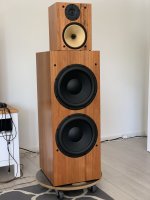
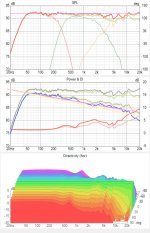
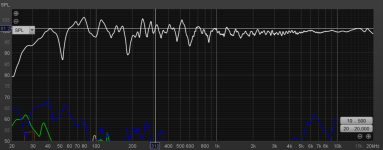
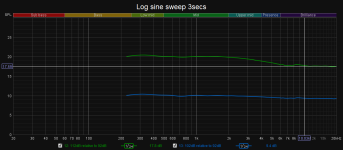
JonMarsh’s project with the twin RSS315HFA8 is currently on hiatus.
It’s not completely clear to me why.
But JonMarsh is now working on a design with a slimmer cabinet with four 8” woofers. In series-parallel wiring the quad RSS210HF4 allows for 91dB/2.83V.
Introduction and distortion measurements are here:
https://www.htguide.com/forum/missi...aëns-planar-aka-smj-40-time-for-a-project-now
Here’s the thread in which JonMarsh designs a 3 way with twin RSS315HFA-8 in 110L.
https://www.htguide.com/forum/missi...9-2021-2023-isiris-update?p=836521#post836521
This is actually the project that lead me to choose twin P830845 in the system I designed in 2021 (and current system main system). It’s one of those old fashioned systems that doesn’t go as deep as a home theatre subwoofer, but enough as a music subwoofer (F3 40Hz or less; F10 30Hz or less) has plenty of output due to its high sensitivity (at 92dB/2.83V (4 ohm)) and ability to reach 12mm x-max with a few hundred watts (~350W/4 ohms).
So it can play at live-like levels. (Distortion tested at 86/96/106… and limits were reached at 110dB/1m where… you guessed it… the tweeter started to show signs of dynamic compression. The woofers and midrange were still ambling along)
Unfortunately the woofers (and midrange) are NLA so I haven’t been motivated to document the design, since no one can build it. I think we missed the XXLS party by a decade. It looks/measures as below:




JonMarsh’s project with the twin RSS315HFA8 is currently on hiatus.
It’s not completely clear to me why.
But JonMarsh is now working on a design with a slimmer cabinet with four 8” woofers. In series-parallel wiring the quad RSS210HF4 allows for 91dB/2.83V.
Introduction and distortion measurements are here:
https://www.htguide.com/forum/missi...aëns-planar-aka-smj-40-time-for-a-project-now
Last edited:
Thank you! It's nice to see the RSS315 distortion above subwoofer territory is also clean. Not so much a subwoofer but just a very capable woofer.
I take it you haven’t heard of our fellow audio nut Monte Kay?
http://www.mfk-projects.com/Home_Theatre/theatre_woofer.html
Here he is, with his TWENTY-FOUR
15” RSS390HF-4 subwoofers in a dipole ‘enclosure’
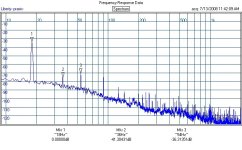
“Click on the thumbnail above for the distortion performance at 18 Hz with a 2.83 volt per woofer input. This measurement was made at the center of the center row with both woofer columns playing but with only two of three modules. The third modules have not yet been installed. The SPL meter was reading 103 dB for this measurement”
When my system is playing at 102dB@ 1m, the quad of 12” XXLS woofers can manage about 17% H2…
He has a point. How can one say distortion isn’t audible; when you haven’t heard really low distortion?
I’ve never heard 1% (-40dB) distortion for a 18Hz tone…
ASR have tested 263 speakers. And run distortion tests- virtually all of their tested speakers have harmonic distortion that go through the roof (5%/-26dB) below 100Hz, when they test at 96dB, from 30Hz up…
http://www.mfk-projects.com/Home_Theatre/theatre_woofer.html
Here he is, with his TWENTY-FOUR
15” RSS390HF-4 subwoofers in a dipole ‘enclosure’

“Click on the thumbnail above for the distortion performance at 18 Hz with a 2.83 volt per woofer input. This measurement was made at the center of the center row with both woofer columns playing but with only two of three modules. The third modules have not yet been installed. The SPL meter was reading 103 dB for this measurement”
When my system is playing at 102dB@ 1m, the quad of 12” XXLS woofers can manage about 17% H2…
He has a point. How can one say distortion isn’t audible; when you haven’t heard really low distortion?
I’ve never heard 1% (-40dB) distortion for a 18Hz tone…
ASR have tested 263 speakers. And run distortion tests- virtually all of their tested speakers have harmonic distortion that go through the roof (5%/-26dB) below 100Hz, when they test at 96dB, from 30Hz up…
Last edited:
Audibility of distortion <100Hz can (of course) be determined using good headphones. And this has been done for sure, but I didn't take the trouble to search for it. Distortion in speaker systems more often than not results in 'fake bass' experience: you think you hear the bass, but it's really the first harmonic (or even the H3). Our ears don't help of course, being practically deaf for frequencies <40Hz you tend to notice the distortion as is a lot sooner than the fundamental. The room influence, with standing waves, interact too, so together it becomes complicated to judge by ear.
Probably also complicated by the phenomena that many musical instruments have louder harmonics than the fundamental. The FFT of A0 on a piano, for example.
Piano is interesting relative to bass: even ( very) steep slope high pass limited @ 50hz it still sound believable in low end register.
Tktran303 can testify! 😉
Low distortion low end on loudspeaker is usually disappointing at first. Once used to it with 'real instruments' you start to notice details which were not present with higher distortion systems.
With electronic music it is imo, disappointing... just that.
Tktran303 can testify! 😉
Low distortion low end on loudspeaker is usually disappointing at first. Once used to it with 'real instruments' you start to notice details which were not present with higher distortion systems.
With electronic music it is imo, disappointing... just that.
I am really glad to discover these results. I have used XLS drivers in a number of projects. Especially 2x10" XLS 830452 as woofers in a 3-way music (not HT) system. A principal attraction is that they can perform with acceptably low distortion up to 200 Hz. This makes them simple to use with a superior mid-range while keeping the mid-range in its safe dissipation range. Very nice. 👍Pity they are no longer available.Just no longer available for retail customers.
Excellent performance even by 2022 standards.
That is totally false. SPL is directly proportional to displacement volume, ie cone excursion * cone area. You will notice that sensitivity isn't involved. Here is the equation for calculating the SPL for a given frequency f, cone diameter d and distance r. I may have r and d reversed. SPL = 100.3 + 20 log(Xmax) + 40 log(f) + 40 log(d) - 20 log(r)More sensitive driver needs less cone displacement (and less Xmax) to get certain SPL level.
Low distortion low end on loudspeaker is usually disappointing at first. Once used to it with 'real instruments' you start to notice details which were not present with higher distortion systems.
With electronic music it is imo, disappointing... just that.
I try not to inappropriately imply ignorance on the part of others, but I have experienced that in most cases, with statements like these, the problem is lack of comparability due to other factors like frequency response and compression.
Fwiw, I can testify that ultra clean / highest fidelity bass, when properly set up and scaled, does not sound boring or underwhelming at all. My references include for example this system, which some years ago I had full access to: https://www.lambda-labs.com/en/references/wall-of-bass
The challenge is context, and language right?
What sounds “neutral, clean, effortless” to one person (eg. 112dB@1m from 40Hz to 200Hz may sound “boring, uninteresting… where is the bass?! (thump/bump” that another person may be habituated to>
Some people like that mid-bass thump?
Whereas others, like yourself, who have heard (and felt) real sub-bass that goes to single digits? You might feel that it's something that too few people get an opportunity to experience. And really should.
I'm sure @krivium has heard real clean bass down to the lowest depths. And by being "uninteresting", I wonder if he means compared to Waves MaxxBass or other harmonic synthesisers that gives the impression of bass. They are interesting?
Here’s my partner’s piano, recorded using AudioControl’s RTA (FFT) during the attack phase of a strike of A0 (mic at hammer position)

H2- Red
H3 - Orange
H4 - Yellow
H5 - Green
H6 - Blue
H7 - Purple
H8 - Grey
H9 - light Blue
H10 - Black
That is the rich spectrum of overtones (aka harmonics) that give the piano its rich characteristic sound.
That’s the deepest bass note on the piano - whose fundamental is apparently 27.5Hz… which I’m not sure I can even see…
Very interesting.
Reference: Yamaha U3 upright piano (2021)
What sounds “neutral, clean, effortless” to one person (eg. 112dB@1m from 40Hz to 200Hz may sound “boring, uninteresting… where is the bass?! (thump/bump” that another person may be habituated to>
Some people like that mid-bass thump?
Whereas others, like yourself, who have heard (and felt) real sub-bass that goes to single digits? You might feel that it's something that too few people get an opportunity to experience. And really should.
I'm sure @krivium has heard real clean bass down to the lowest depths. And by being "uninteresting", I wonder if he means compared to Waves MaxxBass or other harmonic synthesisers that gives the impression of bass. They are interesting?
Here’s my partner’s piano, recorded using AudioControl’s RTA (FFT) during the attack phase of a strike of A0 (mic at hammer position)
H2- Red
H3 - Orange
H4 - Yellow
H5 - Green
H6 - Blue
H7 - Purple
H8 - Grey
H9 - light Blue
H10 - Black
That is the rich spectrum of overtones (aka harmonics) that give the piano its rich characteristic sound.
That’s the deepest bass note on the piano - whose fundamental is apparently 27.5Hz… which I’m not sure I can even see…
Very interesting.
Reference: Yamaha U3 upright piano (2021)
Last edited:
Yes, I understand my fault.That is totally false. SPL is directly proportional to displacement volume, ie cone excursion * cone area. You will notice that sensitivity isn't involved. Here is the equation for calculating the SPL for a given frequency f, cone diameter d and distance r. I may have r and d reversed. SPL = 100.3 + 20 log(Xmax) + 40 log(f) + 40 log(d) - 20 log(r)
There's a bunch of math on this thread that is way above my pay grade. Subsequently, there's a lot I don't understand.
(1) There's very little 'musical' below 40hz. I doubt you'd be able to recognise minor distortion in the fundamental, more so in the overtones which are, in the main, handle by other drivers.
(2) Isn't cone excursion affected by port tuning frequency?
(3) Isn't the relationship between SPL and cone excursion a little confusing? Crank up the volume, play the lead-in on a slightly warped vinyl. With no audible sound your drivers will readily hit Xmax.
(4) For a given size driver, isn't the driver with the larger Xmax is less efficient due to its reduced cone size?
(1) There's very little 'musical' below 40hz. I doubt you'd be able to recognise minor distortion in the fundamental, more so in the overtones which are, in the main, handle by other drivers.
(2) Isn't cone excursion affected by port tuning frequency?
(3) Isn't the relationship between SPL and cone excursion a little confusing? Crank up the volume, play the lead-in on a slightly warped vinyl. With no audible sound your drivers will readily hit Xmax.
(4) For a given size driver, isn't the driver with the larger Xmax is less efficient due to its reduced cone size?
The main reason of lower efficiency of a high Xmax driver is the longer voice coil, which have a considerably weight/ballast which means higher moving mass (Mms).For a given size driver, isn't the driver with the larger Xmax is less efficient due to its reduced cone size?
- Home
- Loudspeakers
- Multi-Way
- Subwoofer High xMax Distortion?